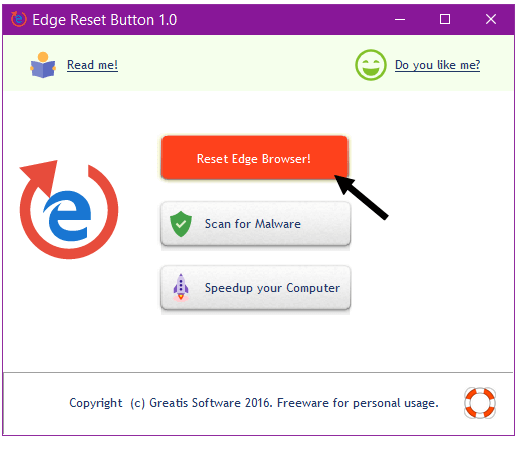A woman brought me her new laptop because her browser, Microsoft Edge, was being blocked with a message claiming her system was infected and to call 1-800-XXX-XXXX. It’s just a scam. I’m surprised that this thing is still around.
I used a small program called EdgeResetButton.
Just install and run it. If your Edge browser freezes up with this ad. Just open the program, click on the Reset Edge Browser! button and you’ll notice the browser shutting down in the background and problem solved. I pinned it to the Taskbar so if it happened again it would be easy to access.
The other two buttons are just trying to sell you something. I ran a scan with Malwarebytes and no infection was found.
—


Silly comment here Terry, but strange that a third party utility has the fix, before Microsoft, Mindblower!
Agreed Mindblower. So much for not needing anti-malware software any more and can rely totally on Windows Defender !
And how do you know this lady was using Windows Defender (now Microsoft Defender) Reg? If, as Terry stated, the laptop was new, chances are it would be running a trial version of either Norton or McAfee. Or, she could have easily installed some other third-party AV.
Hi Jim – am a little confused by your reply ?
What I assumed Mindblower to be saying was that if Edge was being hijacked by advertising malware then one would have expected that Microsoft itself would have been able to prevent it in the first instance given that it is a Microsoft product under attack. However if a version of Nortons or McAfee was in use and was over-riding Microsoft Defender then you would think they too would be looking out for this sort of malware as well and blocking it – so having to use a third party fix to repair the problem (whichever one was responsible for the browser being hijacked as you described) seems a bit of an embarassment for whichever it was.
I note that I have Windows Security as it seems to be called now running happily alongside my Norton Security software in the taskbar and doesn’t seem to be completely diasabled by Nortons as it used to have to be some time ago but when you delve further into the options it seems that much of it is deferring to Norton Security to do the actual protection when that is installed. In fact I tried to enable it to allow it to do it’s own thing and immediately got a warning from Nortons to turn it back off again as it could interfere with same.
Thanks for the info – if I get the same issue on my PC with Nortons running I’ll let you know.
Hey Reg,
Microsoft Defender and Windows Security are entirely different animals. Microsoft Defender is an active antivirus including real time protection whereas Windows Security is in no way providing any sort of protection. When a third-party antivirus is installed, Microsoft Defender is automatically disabled and Windows Security is then merely keeping you informed of the status of your resident antivirus which, in your case, is Norton. If, for some reason, Norton is not active or not up-to-date, Windows Security will notify you of the situation. So, all Windows Security is doing is keeping an eye on Norton for you to make sure it is up-to-date and fully operational.
As far as browsers are concerned; it is neither difficult nor uncommon for a careless user to inadvertently infect their browser and Edge is no more susceptible to the type of scam described in this article than any other browser. You are quite right in saying that something has let the user down by allowing the infection through but then no antivirus product protects against 100% of all malware and/or adware, and they certainly cannot always protect users from themselves. That’s why third-party solutions such as MBAM (free), AdwCleaner, etc, including the one Terry used, remain important tools.
So, my point was; your comment appeared to be blaming Microsoft Defender for allowing the browser to become infected but we have no way of knowing if Microsoft Defender was even protecting this particular laptop. If the lady was running any 3rd-party antivirus then Microsoft Defender would, in fact, have been disabled.
Hope that clarifies for you mate,
Cheers… Jim
Yes thanks Jim – I see it now. I didn’t realise they were two separate beasties – just thought it was a naming change. I still haven’t been able to trust Microsoft to protect me though -maybe it is now as good as the other paid or free versions as I have heard it is but I am used to Norton Security for many years now and I know it has saved my bacon a few times when I have clicked a dodgy link that initially seemed legit.
Thanks again for clearing up my misunderstanding.
Cheers Reg
No worries Reg. When it comes to antivirus solutions I am a great believer in whatever works for the individual. If you’re happy with Norton and it’s doing a good job for you then it’s the best solution for you.
Cheers mate… Jim
Someone clicked on some click bait link, probably while using Facebook!!!